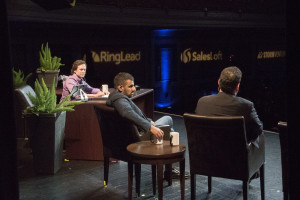
We’re publishing the full series of transcripts and videos from all of the epic SaaStr Annual 2015 sessions (check out the Partnering with the Big Guys, Hyperscaling Inside Sales with Zenefits, the inside scoop on Why Sh*t Gets Funded, and the unicorn journeys of Slack and Yammer posts if you missed them).
This week Aaron Ross, author of Predictable Revenue, interviews repeat founders Nick Mehta, CEO Gainsight, Mark Organ, CEO Influitive and Kris Duggan, CEO Betterworks. These “second-timers” candidly share the lessons learned from their first go-rounds as a founder. Learn what they are doing differently (or the same) this time around from raising money, to hiring strategies, to balancing family life. Whether it is which executive to hire first, or what they’re determined to do better, this interview offers a tremendous amount of insight into what’s always hard, what gets easier, and the mistakes to avoid at all costs.
Check out the full transcript from the session below!
Also, make sure you grab your ticket to the 2016 SaaStr Annual. Join 5,000 SaaS founders, execs, and investors for 3 full days of inspirational content and unparalleled networking. Everyone will be there. You can’t afford to miss it.
Aaron Ross: All right. Thank you, everyone.
Nick Mehta: Cheers.
Aaron: This is the Second Timers Panel. Second Timers. I’m Aaron Ross. Right now, we’ll start with Nick here. Now, I know you’ve… Did you introduce yourself last time?
Nick: Not really, no.
Aaron: OK. Now’s your chance. By the way, before we start, we have to get a picture together, because again, I told you my three year old loves, loves, loves Purple.
[laughter]
Aaron: Nick from Gainsight.
Nick: I’m Nick from Gainsight. You’ll be talking about the company?
Aaron: Give me a 60 second pitch.
Nick: 60 seconds? That’s way boring.
[laughter]
Nick: We’re trying to help companies do a better job of driving massive success for their customers. And also keeping their clients, and helping to drive more revenue from them in the process. We do that for lots of small, medium, and large sized SaaS businesses, as well as companies in other industries.
Aaron: That’s great. Mark?
Mark Organ: Hey everybody. I’m Mark Organ, I’m CEO of Influitive. We help companies mobilize their army of customer advocates. If you’ve ever wondered, “How can we get more referral leads and set up reference calls and get case studies and testimonials, videos, social buzz?” We can help you do that.
We work with lots of great SaaS companies, including some right here in the room. Thanks.
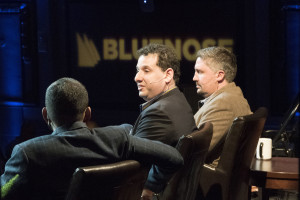 Aaron: By the way, I was thinking like we probably met when I was just starting up a team on Salesforce, a long time ago.
Aaron: By the way, I was thinking like we probably met when I was just starting up a team on Salesforce, a long time ago.
Mark: That’s right, 2001 and you were amazing.
Aaron: And then Kris, again, actually I’ve met about the same time.
Mark: Many years ago, yeah.
Kris Duggan: Kris Duggan, CEO and co founder of BetterWorks. BetterWorks is an enterprise goals management platform. What that means is we help medium to large companies really rethink how their doing goal setting and getting their entire workforce aligned, engaged, motivated and really executing at the highest level possible.
Aaron: The whole point of this session, especially to go through, what are all the worst screw ups you made that you’re doing differently this time or telling people not to do. Nick if you think back…a little bit about your prior company and then what you’re doing differently this time?
Nick: First of all, I was in LA, that’s very different than now here in Bay Area which is totally different scene. It’s called LiveOffice is the last company I ran. It was a SaaS company in the email archiving space, selling to corporate legal departments. Very exciting. We built a nice business company but then eventually sold it to Symantec. That’s what we did.
Aaron: And you moved back to Bay Area?
Nick: I was actually commuting back to LA which is brutal.
Aaron: I live in LA.
Nick: You live in LA.
Aaron: Now I’m…OK. What’s one thing, start off, one thing around…Actually, I’m going to say that how do you think about raising money? Let’s say that you’re doing differently, you did differently this time, did you raise it sooner, later, more from different people?
Nick: Yeah. It’s interesting, the last company, I didn’t found it but it was actually bootstrapped, we never really raise any capital that came into the company. There were some investors that bought shares from the founders but we never brought any money in.
This, a game site, we’ve raised a little bit of money, a decent amount of money. It’s actually radically different because you can make investments that don’t all have to pay out right away. Some things are good about that, some things are challenging but one of the things that’s great is you can really go for it.
Aaron: In what way? Give me example. Are you hiring more people, hiring executives sooner? What’s one of the ways you’re going for it?
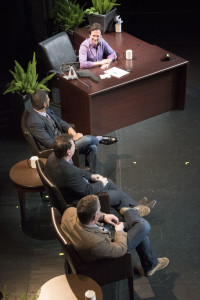 Nick: It’s interesting because we have an awesome team at LiveOffice but the ability for us to attract talent, when you’re able to both pay good rates but also have a vision that’s going to be really really big. That’s allowed us to track a team that has an ambition that’s aligned with that ambition which is really exciting.
Nick: It’s interesting because we have an awesome team at LiveOffice but the ability for us to attract talent, when you’re able to both pay good rates but also have a vision that’s going to be really really big. That’s allowed us to track a team that has an ambition that’s aligned with that ambition which is really exciting.
Aaron: Mark, who is the prior company? A little bit about that.
Mark: Prior company was Eloqua. Eloqua was or still is, I guess, well, part of Oracle now but…
Aaron: Hey, don’t be modest.
Mark: [laughs] …Yeah, Eloqua is a marketing automation software company. One of the earliest ones founded in 2000. Also, was a bootstrapped company for five years before we raised a serious capital. We’ve got profit along $166,000.
Aaron: Was that because you didn’t try to raise money or you did try but couldn’t?
Mark: We did try to raise money, nobody would give us any money.
[laughter]
Mark: Part of it was we were based in Toronto, which we still are, at Influitive, there’s not as much venture money around but it was a team of… I was the oldest person in the company at 25. We didn’t really have that kind of team to really inspire raising money. Also, it was post April, 2000. So the things aren’t really… go downhill.
At Influitive, we raised money earlier, although not a lot of money all at once. We still did first raise a couple hundred thousand and then raised a little more. It wasn’t until we hit some semblance of product market fit that we started to actually raise a significant seed round, that was just around over three million dollars.
At a degree, a big difference is just a time arising. Like at Eloqua, we didn’t do the first Dreamforce because we weren’t going to get a payback fast enough. We needed to get a payback in four months or less and at least a 3x return on investments within a year, in order for any marketing investments to make sense. When you’re…
Aaron: Basically it’s because you’ve got cash flow.
Mark: Yeah, you’ve got cash flow you needed to get payback quickly. There’s just so many investments that you can’t make. Now, it’s nice to have a little more but not a lot more. I mean, instead of getting payback in four months, it’s now maybe payback in 10 months but it is nice to be able to make a little bit more perspective investments.
Aaron: Actually, when you raised, say, the three million dollar around, was there one thing that you were the most excited to spend money on? Was it a certain kind of executive to have maybe, get your expense account repaid?
Mark: The thing I was most excited about and it’s been a transformational hire, for me, is the chief of staff. Chiefs of staff are not really that common yet, but my prediction…
Aaron: They should be.
Mark: Is you’re going to see a lot more of this. It’s a really great role. Chief of Staff is somewhere between an EA and a COO. I realized those are pretty wide fence posts there between those two. Like an EA, they work just for the CEO. They don’t have anybody reporting to them. Like a COO, they’re pretty senior people who are capable of doing a lot.
What I think a lot of companies need are a super-human CEO. You need to be at three different places at the same time. How do you do that? You do that by having somebody really capable that you work as a team all the time.
I hired an amazing chief of staff in Fraser Stark who’s now our VP of Talent. He’s building out our HR practice. A new great chief of staff in David Axler. Really quite a transformation hire. I’m happy to talk to anybody about that, if you’re interested.
Aaron: That’s a great idea. Then, Kris, what was your prior company?
Kris: My last company was Badgeville. I started that in 2010. Our seed round was 300K. With BetterWorks, our seed round was about two and a half million dollars. Then, our A round at Badgeville was two and a half million dollars. The A round at BetterWorks was about twelve and a half million dollars funded by Kleiner Perkins.
We’re still a year into BetterWorks, but the company is about 40 people now. We’ll probably double this year. It’s still early days. I would say last year was really about finding product market fit, so we didn’t want to get too far ahead of ourselves on the sales and marketing side.
In fact, we only launched the company in September. Most of the head count is actually in the product and engineering. Now, we feel like we’re finding that and we’ve found it. Now, we’re ready to start execute.
I guess the financing enables some of those things that maybe…We don’t have to be out there worried about fundraising all the time. Or, “I wish we could make this investment.” We can be a little be a bit more opportunistic around where we really want to drive some leverage in the business.
Aaron: Actually, in that case for you, what were the first couple of executives that you want to hire that were on your list?
Kris: In the early days, it was actually a co founder who was a very strong engineering lead. The next hire was a customer success leader, and actually a co founder. Then, the next hire was a product leader. For the last year, I’ve actually been running sales. I actually can’t wait to fire myself and bring somebody in. Then, after…
[crosstalk]
Mark: …You just have to miss a quarter a few times, you can fire yourself. [chuckles]
Kris: That’s right. Then, I’ll have a hard conversation with myself.
Mark: [chuckles]
Kris: Then, brought on a really strong marketing leader in the last six months. Now, we’re actually ready to kind of fill the next key hire, which is the sales leader. Besides maybe a CFO or the head of finance, that fills out the executive team in terms of what the company needs for this middle stage of growth.
Aaron: I think that there’s a story in Silicon Valley. If I just build this great app, I’m going to get a whole bunch of people who come inbound to me, download and buy it. I’ll just be able to just sit there and code.
Did you have that kind of thinking at some point? But, as part of that, now, the way that you think about what drives growth, do you have different levers in your head? In the past, you thought about product would drive it or just product. Now, you think something else in terms of your primary growth levers. Nick, where do you stand on that?
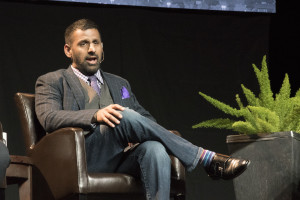 Nick: I think a lot of it depends on are you doing something that is a new iteration of something that exists already? Are you doing something new? Actually, Mark has done a great job of talking about category integrations. I won’t steal his thunder too much.
Nick: I think a lot of it depends on are you doing something that is a new iteration of something that exists already? Are you doing something new? Actually, Mark has done a great job of talking about category integrations. I won’t steal his thunder too much.
Basically, I think if you’ve done something new, what’s going to drive growth is going to be evangelizing that new thing and getting people to believe in it. Whether it’s advocacy, advocate marketing or customer success or helping companies better run towards their goals.
A big part of it is just getting the people to believe in your idea. Frankly, it’s very different than having a product that you’re serving a need that exist and you’re just doing it better. Here, you’re trying to evangelize a concept at least I think we are and you guys are as well.
Aaron: Actually, I will say that when people try to learn about how to do customer success. Gainsight, your site has a lot of really, really good information on even how to think about it and sell the idea without even talking about the software.
Nick: That’s definitely what we’re trying to do. It’s interesting because we basically say we have two missions in our company. The number one mission is to help people be great at customer success and that involves a community and content. Then, a means to that mission is to build software to help enable that.
But just get realistic that, at least for us, technology is 10 percent of the problem in most business areas  and 90 percent is the other stuff. So as a vendor, if you can help people with the other stuff, I think you earn their trust on the technology side.
and 90 percent is the other stuff. So as a vendor, if you can help people with the other stuff, I think you earn their trust on the technology side.
Aaron: Mark, how does growth trigger change from the first time to the second time?
Mark: How growth triggers…
Aaron: Levers…When you’re thinking, “What’s going to drive growth?”
Mark: There are some differences.
Aaron: Or how do we grow faster?
Mark: That’s one of my favorite topics these days. It’s interesting. Very much on my mind. In fact we’re in the process of raising our series B right now. For a few months we struggled with it. I actually had a conversation with Jason Lemkin and said, “What’s going on?” He said, “How fast are you growing?” I’m like, “11, 12 percent a month.” He’s like, “Not good enough. You got to hit 15.” You know what? He’s right.
These days the market wants growth more than anything else. It’s a great question to think about how to grow faster. Up until now, our focus has been on trying to get as many committed logos as possible. What a committed logo is, is a new company that buys a product and is very committed to it and they want to really see the program work.
We figured out the price that we need in order to get the customer to go and put someone really good on the product so that we can generate more advocates, and that’s actually the way that we’ve grown up until this point and it’s been quite successful for us.
But now we’re adding some new levers. A big one for us is cross sell and upsell. Which up to this point has been kind of an afterthought, and now is something that we’re thinking about a lot.
Now, product is starting to drive more sales. So every six months, we have a new module that’s coming out, like clockwork. Some products are really turning almost into the sales function. We started first with an event management module that we call Experiences to run something very much like this event. You can get advocates bringing prospects to the booth and that sort of thing.
What’s coming out in a month and a half is a fantastic new community product so you can get advocates much more involved in your community. Six months after that we’ve got a surround selling product coming out. That cadence is going to start to drive a lot more growth. Another thing that we’re starting to think about now too is enterprise, and true enterprise.
I distinguish between divisional growth and enterprise growth. You can win a company by winning one division at a time and you’re great at that at salesforce.com. But now we’re starting to add real heavy hitter salespeople that can come in at the top and sell a million dollar deal right up front.
Aaron: Always a good thing?
Aaron: Kris, same thing. What did you try to do for growth before that you thought maybe didn’t work out or you’re trying to do differently this time?
Kris: When you’re strapped for cash and you’re always going out and trying to pitch investors, you always end up in this reactive mindset. If you have a little bit more luxury of time and thinking ahead and planning how you want to orchestrate your business.
I would say a key thing that I’ve really spent the last year thinking about is how do we build a really strong foundation? It’s not just about “Go out and get customers and bookings.”
By the way we brought on about 50 enterprises last year and we did 7 figures in bookings. But it wasn’t just that that’s the only thing that matters. It was, “Let’s really nail this messaging so that we actually understand what resonates with our target market. Let’s figure out customer success and how we implement this solution that we actually are going to drive delighted customers.”
It’s, “Let’s figure out, what really is the core product hook? Are we actually selling adoption and usage or are we just selling contracts?” To me, I think, the second time around, it’s really thinking of it more as harmonizing. How do you harmonize the functions of the business so that not one function is too far ahead of itself? While you’re still growing really fast… we’re going to double again in head count this year. 
Even if you’re still doing all of those things, you know you’ve got a strong culture. You’ve got a great filtering mechanisms for bringing in the right people. You know what your target market looks like and your ideal customer. You know how to onboard them and actually deliver value. While you’re delivering high growth, you’re still doing that in a way where the train’s not going off the tracks.
Aaron: Yep. You’re delivering happy customers who will be advocates.
Kris: Exactly.
Aaron: Along those lines, first time entrepreneurs…I was one quite a ways ago. We have these fears. You have different fears this time, but what’s something that you either worry about less or you’re not worried about this time that you were worried about the first time? Nick?
Nick: Honestly, I still worry about the same stuff. If you’re a first timer, I hate to tell you the truth, but it’s still really hard the second time. The second timer things are interesting, because you think you learn all this stuff.
But the world changes too. At my last company, 2008, we sold in early ’12. The world’s pretty different now and frankly I learn just as much from early CEOs doing it the first time as I do from people doing it four times.
But the one thing I will say I’m not as afraid of is failure. I’m actually more afraid of not having massive success. You basically move the goalposts for whatever you want to do. For me the fear is we think we have a big opportunity here. How do we make sure we’re the company that took advantage of it versus the one that could have done it and didn’t?
Aaron: So not playing safe.
Nick: Not playing safe. That’s exactly right.
Aaron: Might as well just go for it.
Nick: Yeah. That’s one difference.
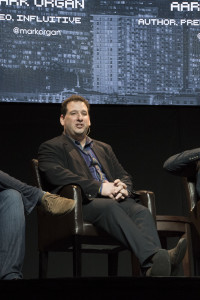 Mark: I worry less about the number. I was always really obsessed about hitting the number every month and every quarter at Eloqua. It’s still really important to hit numbers, but I obsess about the team a lot more. Team, team, team. I do things on purpose like I disappeared on the last day of our fiscal year and went skiing. My only job was to click Sign on the digital signature.
Mark: I worry less about the number. I was always really obsessed about hitting the number every month and every quarter at Eloqua. It’s still really important to hit numbers, but I obsess about the team a lot more. Team, team, team. I do things on purpose like I disappeared on the last day of our fiscal year and went skiing. My only job was to click Sign on the digital signature.
That’s awesome to do that on chair lifts, by the way. It just feels great.
[laughter]
Kris: How excited are you?
Mark: Yeah. It’s the team that drives all the value and the more you can invest in them, and less about muscling things on your own…
Aaron: Just brute force.
Mark: Just brute force on your own just so you can heroically hit that number, I think the more success you’ll actually end up having and paradoxically you’ll hit a lot more numbers in the future, especially when things get bigger and it’s harder for you to muscle things on your own.
Aaron: Kris.
Kris: I would say one thing I’m doing differently is at Badgeville we raised $40 million in capital and went through a pretty accelerated series of financings. I was always looking for the super senior leader to hire in each functional area. I was so proud of this executive team that I had put together.
Very senior sales leadership, marketing leadership, biz dev, customer success. Finance. Just across the board. And they’re so senior.
What I realized, this is like their third time doing the job, and John Doerr likes to talk about this difference between missionary and mercenary. What I found was with all these senior people, they actually don’t like talking to each other. There’s a lot of politics that start to get played. It’s just the egos or whatever it is.
 Actually with the new company, I’ve been really focused on finding the up and comers. That’s not to say junior, so I’m not saying junior and no experience. I think it’s like give people the chance to really shine in this new role and expectation, what’s possible from them and really kind of give that type of persona, that profile, a shot. So far, it’s working out great for us.
Actually with the new company, I’ve been really focused on finding the up and comers. That’s not to say junior, so I’m not saying junior and no experience. I think it’s like give people the chance to really shine in this new role and expectation, what’s possible from them and really kind of give that type of persona, that profile, a shot. So far, it’s working out great for us.
Mark: I agree. That’s been my mantra too. I’ve learned that the hard way as well.
Nick: I also think one way to think about it is if the role demands experience and it’s been the same for a long time, then the experience is relevant. I don’t know, at least for us, in area like finance or something like that, it might be where you put some premium on experience.
To tackle your point, a lot of our leaders in our company including our marketing leader, who’s here in the audience, Anthony, somewhere. Basically, kind of grown up through the company and done amazing job because the world is changing so much that the role of a marketing leader is pretty different than it used to be.
Kris: I think it’s a balance. It depends on what the company needs. There’s all these research that shows that the founder CEO outperforms the professional CEO, but maybe also extending that to the leadership team as well. It’s the same concept.
Mark: No. I think experience is still important. I feel that there’s not a gap there if there’s not a learning, if there’s not the occasional holy shit moment. Then, I do think you get potentially a team of mercenaries. In the case of the finance, that’s an interesting…The way we tackle that, I think a lot of people here also is through a part time CFO.
The person who really runs our operations and finance, she is learning a lot every day. She’s guided by a really senior person who comes in one day a week to help. I think that’s the way we’re getting kind of both on that.
Kris: Like the CFO of Dropbox, for example, a very successful person. This is their first time doing the role.
Nick: One other thing we think about a lot is that the super senior people, I think, could add value at least to our company and maybe yours as well. Actually, I think some of the best super senior people, because they’re really senior and everyone wants them, they can go to the most risk reduced company out there that’s much further along.
So, one of the things to watch out for is don’t hire a super senior person that couldn’t get all the job for later stage companies, and they kind of settled for your earlier stage company.
Some of the most senior people at LinkedIn, Facebook or Twitter, they’ve got the pick of the litter. The question is who’s talking to you. Make sure they’re people you really want.
 Mark: These all sounds well and good. I just want to make an important point for people here. If you want to hire these kinds of people, it’s a lot of work if you want to uncover the up and comers. These aren’t the famous people. These are the diamonds in the rough. It means you got to spend, frankly, a lot of time recruiting and I do. I spend at least a quarter of my time recruiting.
Mark: These all sounds well and good. I just want to make an important point for people here. If you want to hire these kinds of people, it’s a lot of work if you want to uncover the up and comers. These aren’t the famous people. These are the diamonds in the rough. It means you got to spend, frankly, a lot of time recruiting and I do. I spend at least a quarter of my time recruiting.
Aaron: Last night, you mentioned there’s someone you’ve been recruiting for three years.
Mark: Yeah, the head of sales that we have. Literally, we’ve had a relationship with her for 10 years. The thing is the faster you grow, the more you’ve got to focus on recruiting because you got to push it out even out further.
I’m going to Asia in four or five months. I’m starting to look for a head of APEC. I’m not going to APEC for like two years. If you don’t start that process soon, if you don’t start that process on…that CFO that could take your company public. Again, if you’re growing like this, you’ve got to be recruiting all the time.
It sounds good. I do really advocate for finding these up and comers, but it’s work. That means you’re always talking to people. You’re saying, “Who’s that great team lead developer, the great junior product manager who’s a rocket ship on the way up?” That takes work. Although, I do think there’s a huge pay off on it, and that’s why I spend so much time at it.
Aaron: It’s funny. I’m just trying to keep up with changing diapers at home.
Mark: [chuckles]
Aaron: I can’t think about a year or two. I guess that’s why they call them CEO who’s up here.
Kris: Actually, related to that. It’s easy to say, “Oh, well, second time around, you can get Kleiner Perkins involved.” It actually took me probably about three years to build a relationship with Bing Gordon, who I actually pitched multiple times to get involved with Badgeville. He kept passing, didn’t want to be in the deal.
We had a great relationship. Finally, when I went off to start something new, I took it to him and he got really excited about it. It wasn’t like I just knocked on the door and said, “Hey, can you fund this opportunity?” It’s something that had been building for many, many years.
 Nick: I think it’s a really great point for folks that are first timers. What you’re doing now, if you’re going to do this again ever, is building up those relationships for the second time, so don’t screw anyone over. [chuckles]
Nick: I think it’s a really great point for folks that are first timers. What you’re doing now, if you’re going to do this again ever, is building up those relationships for the second time, so don’t screw anyone over. [chuckles]
Mark: [chuckles]
Nick: Be nice to people.
Mark: That’s true.
Nick: Return their emails, things like that, even if they leave your company, even if they compete with you. It’s a small valley. Relationships matter.
Aaron: Don’t be an ass. Actually, important question because you guys all have kids, correct?
Nick: Yeah.
Aaron: I think two each.
Nick: Three.
Aaron: Three, two, two.
Nick: Do we have as many kids collectively as you do or no?
Aaron: What? [laughs]
Nick: How many kids do you have?
Aaron: Five. At least two more on the way through adoption. This is not a competition.
Nick: A bit of a race. [chuckles]
Aaron: First time, I don’t know how many… I know Mark, you didn’t have kids, some maybe did. How are you thinking about or making decisions around whether it’s family or personal passions, whatever, as first timers? Now, how do you think about and make those kinds of decisions where you spend your time?
 Nick: Well, obviously, we’re employing all our kids in our companies as much as possible, [chuckles] so lots more labor…
Nick: Well, obviously, we’re employing all our kids in our companies as much as possible, [chuckles] so lots more labor…
Aaron: [laughs] It’s the future of recruiting, right?
Nick: SDR. They could definitely open up doors.
[laughter]
Nick: That’s what SDR is, right? Actually, it’s funny. I don’t actually mean magic. Obviously, I love my kids. I love my work.
The only thing I’ll tell you is the greatest thing that’s happened to me in maybe forever is my daughter, whose eight years old and is at fourth grade, was taking a practice test. She got a question wrong. She’s pretty smart, so she doesn’t normally get questions wrong.
We’re like, “What was the question you got wrong?” They asked her what the opposite of work was. It was supposed to be play. She’s like, “But daddy has fun at work.”
Aaron: [laughs]
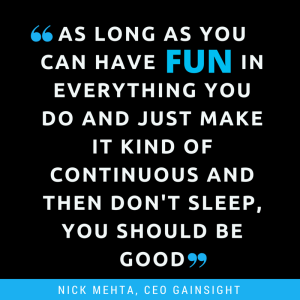 Nick: Honestly, the way I rationalize it is as long as you can have fun in everything you do and just make it kind of continuous and then don’t sleep, you should be good.
Nick: Honestly, the way I rationalize it is as long as you can have fun in everything you do and just make it kind of continuous and then don’t sleep, you should be good.
Aaron: Actually, to flip the question whether how you make the decision between the two or integrate them.
Mark: This is hard. I’m still really working on this. I’ve got a busy working wife. She’s a doctor. She works as hard as I do. Our life is a welter of nannies, in laws and crazy scheduling all the time, so something that I’m still working to try to get right.
I think things are really starting to come together for us now and any part of it is just putting…I still do. I put my family first. We’ve actually made it a part of the values of the company. I want to have an integrated life, so we made that one of the core values of the company.
I try to lead by example as much as possible. When I go on vacation, I always send pictures. I always make a point of saying, “You can not contact me.”
[laughter]
Mark: Trying to encourage people to take care of their families, their personal health and everything else like that.  That’s way harder than building a company again. For me, it’s trying to figure out how to be a great husband, father and son to my parents, but also try to build a billion dollar business in the next four and a half years. [chuckles]
That’s way harder than building a company again. For me, it’s trying to figure out how to be a great husband, father and son to my parents, but also try to build a billion dollar business in the next four and a half years. [chuckles]
Nick: One thing to add to that, by the way, to Mark’s point, which is a great one is, although it is hard, you have a lot of control of many of your CEOs. There’s nothing that happens to you. Nothing happens to you. You choose to go to the extra meeting, respond to the extra emails, et cetera.
You’ve got a lot of choice. One thing is to embrace that choice. Also, you have impact in everyone else in the company.
One little thing we do which, by the way, I highly recommend for every company is one of our of rules. No email on Saturdays. No one is allowed to send an email on Saturdays. If anyone sends an email that’s not urgent customer on fire type of situation, then everyone else is like, “Dude, you sent the email on Saturday.“
Because if somebody sends an email on Saturday, everyone else feels obligated to respond. I think, as a CEO, you actually have a lot of power, not only over your own life, but other people’s as well.
Kris: I guess for me, I think people should set their own boundaries. We don’t kind of say you should do it this way or that way. I think we have a lot of 25 year olds at the company. They work at the office until 10 o’clock at night. We serve lunch and dinner.
Aaron: More power to them.
Kris: They, then, hang out. Then, they’re playing Nintendo on the big screen after hours. Then, we also have a lot of people with kids and families that this isn’t their first or second startup. They’re kind of pacing themselves.
They know that we’re in a long term committed kind of journey with this company. It’s not going to be an overnight thing. We’re not looking for an exit or a flip. We’re in this for the next seven to 10 years. We think about it that way. I get home at 6:30 for dinner every night.
I do work on the weekends. I don’t mind sending emails on the weekends. If somebody doesn’t reply until the Monday, if it’s not critical, then I think that’s OK.
I guess the flipside is I’ve also seen a lot of CEOs that are working 70, 80 hours a week. There’s a point where they actually just lose being productive or adding value. Maybe that’s an older way of kind of thinking about this.
 Aaron: I find, over the years, if I work more than 30 hours a week, which sometimes I do, I lose sight of the forest to the trees or trees to the forest, one of those. I don’t remember how it goes.
Aaron: I find, over the years, if I work more than 30 hours a week, which sometimes I do, I lose sight of the forest to the trees or trees to the forest, one of those. I don’t remember how it goes.
Actually, I will say I haven’t done it recently, just bringing a kid on a speaking trip has been a fun way to get private one on one time. They get a lot out of it. I think it’ll be harder as they get older in school. It’s being creative and how you integrate the two. In fact, I got the questions yesterday morning. “Who’s going? Are we going to go?” “No, you can’t. Not this one.” [chuckles]
Let’s go back to money. Ultimately, as a CEO, you want to be able to feel good and part of that is hitting financial goals. When you started out or as you’re starting the second time…Something that, I think, all three of you are doing are creating new categories or at least expanding, exploring. Was that something you chose to do? Was that just how it ended up happening as you got it off the ground?
Nick: Let me start. I definitely didn’t choose to start to create a new category. Honestly, customer success was really hard in my last company. Then, this thing just seemed like it was a big opportunity and something that needed to be solved. I didn’t think of it as I wanted to do a new category.
 Now, once you’re in it, you’re like, “Oh, my god. There’s a new category. This is exciting.” Then, you’re like, “Oh, my god. There’s a new category. This sucks.” Then, you’re like, “Oh, my god. This new category is exciting.” Then, you back and forth all the time.
Now, once you’re in it, you’re like, “Oh, my god. There’s a new category. This is exciting.” Then, you’re like, “Oh, my god. There’s a new category. This sucks.” Then, you’re like, “Oh, my god. This new category is exciting.” Then, you back and forth all the time.
You’re just really passionate about what you’re doing. We have a freaking irrational passion for customer success at Gainsight. Most people think we’re weird, but we love it…
[crosstalk]
Aaron: Actually, you’re sort of weird, but I like it.
Nick: Exactly.
Aaron: I like the robots downstairs. [chuckles]
Nick: Thank you.
Mark: I just think it’s the way I’m wired. When I left Eloqua, I…
[crosstalk]
Aaron: …Did something new.
Mark: Quite a famous VC said, “I will write you a 10 million dollar check right now if you build a plan to compete…Build Eloqua 2.0, I’ll write a 10 million dollar check right now.” I said, “Let me think about it.”
I just couldn’t do it. It wasn’t just because I’d compete potentially with my former company, but I’m just bored. I just think life is too short to go and do something all over again. Maybe just being a pioneer is the way I’m wired.
I also felt like, “Hey, I kind of figured out a little bit how to do this in my last company. Wouldn’t it be great if I could do it better this time around?”
 Kris: I would say I was pretty deliberate with the process of starting the new company. It started with me experiencing the pain of this problem actually at Badgeville where I was trying to get everybody kind of mobilized, focused on the right things. We couldn’t find any off the shelf software for this, and so we used Chatter and PowerPoint.
Kris: I would say I was pretty deliberate with the process of starting the new company. It started with me experiencing the pain of this problem actually at Badgeville where I was trying to get everybody kind of mobilized, focused on the right things. We couldn’t find any off the shelf software for this, and so we used Chatter and PowerPoint.
I thought, “There must be a more collaborative, open, transparent, kind of Fitbit style way that kind of drive this alignment at scale inside companies.” In Q4 of 2013, when we were just kind getting started, I went out and talked to 85 companies.
Aaron: 85?
Kris: 85 companies in one quarter. Some were big. Some were small. Some were medium sized. Some wanted to buy the product if we had it. We learned a lot, that, at some companies they do 80,000 word document once per year to run this process. I realized there was something there.
That catapulted the company. But the last thing I wanted to do was spend five years, one year working on something that I didn’t feel I had tremendous, horizontal broad base applicability. I was really delivered making sure that we really did get that feedback.
Nick: I was going to say, one last thing on new category, what’s awesome though is you do use your brain a lot. My last company was the cloud version of something that was there before, there’s no playbook. A SaaStr is super help obviously, but there’s not like a playbook for new category which Odyssey is pretty exciting.
Aaron: To wrap up here, to the first timers in the audience. Again, second back, there’s one piece of advice you want to…Or maybe it’s your old you but to the first timers, just one piece of advice to do or not do. Anyone who wants to jump in?
Mark: You have to go and go first every time. I think, the best piece of advice that I could give is to obsess about your team. That means, everything from the home team, the people that you have at home, to your executive team, to the broader team and to your board.
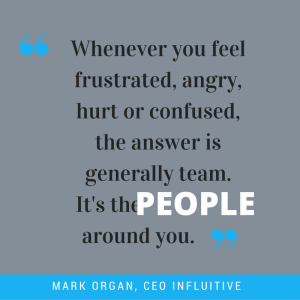 I got some really good advice, once, from my old board member at Eloqua and that is, “Whenever you feel frustrated, angry, hurt or confused, the answer is generally team. It’s the people around you.” That’s generally the answer and I’d say that, really think about that first and a lot of things get better.
I got some really good advice, once, from my old board member at Eloqua and that is, “Whenever you feel frustrated, angry, hurt or confused, the answer is generally team. It’s the people around you.” That’s generally the answer and I’d say that, really think about that first and a lot of things get better.
Aaron: Great point. Kris?
Kris: Besides seriously thinking about goals, advocacy and customer success, those are obviously very important areas.
Nick: Very very important.
Mark: Yeah. [laughs]
Kris: I think, if you have the ability to and the luxury…
Aaron: …And prospecting.
Kris: Prospecting, that’s right. Plan for success and think long term. It kind of back to the missionary, mercenary thing. One thing I noticed with those particular folks is that, they’re always thinking, “Oh, the companies going to get acquired.”
Aaron: When is my payday?
Kris: “If we do a deal with Oracle, what does that mean?” That kind of culture can be very negative. Planning for success, really thinking that this is…We hear all about this overnight successes and the reality is they’re 7 to 10 year journeys, particularly in SaaS.
We’ve seen that time and time again in the B2B software, it is a journey. Plan for success, think long term if you have the luxury, and if you orient everybody in your team to that type of missionary viewpoint. I think that has amazing impact.
Aaron: Bring it home here?
Nick: Sure. My last company was eventually sold and it was great but the times I look back on fondly are the times, like the times right now, that all of you’re in. Basically, this is the time that you’ll remember, years from now. Everyone’s focusing so much on the exit or whatever is going to happen but actually, later on you’ll remember this time.
 You’re actually living in the most fun time, right now, even though it sounds absolutely horrible sometimes, so enjoy it.
You’re actually living in the most fun time, right now, even though it sounds absolutely horrible sometimes, so enjoy it.
[laughter]
Aaron: You’re saying is, it’s the journey not the destination.
Nick: Something like that, exactly.
Aaron: I don’t think they’re…No, it’s true but we’ll say that. Actually, I would say that a lot of companies sell product and they’re made to make your customers successful with your product.
You’re actually not there to make your customers successful with your stuff, you’re there to make them successful, whatever they may need which may or may not include the app you sell. Don’t be afraid of services, of content, of anything else it takes to make them successful.
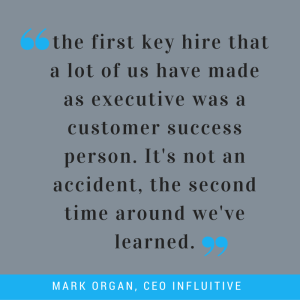 Mark: Yeah, I think you’ll find that in common with all three of us, right? I mean, the first key hire that a lot of us have been executive was a customer success person. It’s not an accident, the second time around we’ve learned.
Mark: Yeah, I think you’ll find that in common with all three of us, right? I mean, the first key hire that a lot of us have been executive was a customer success person. It’s not an accident, the second time around we’ve learned.
Aaron: OK, hey, thank you guys very much, appreciate it.
[applause]
Aaron: Nicely done.
Transcription by CastingWords


